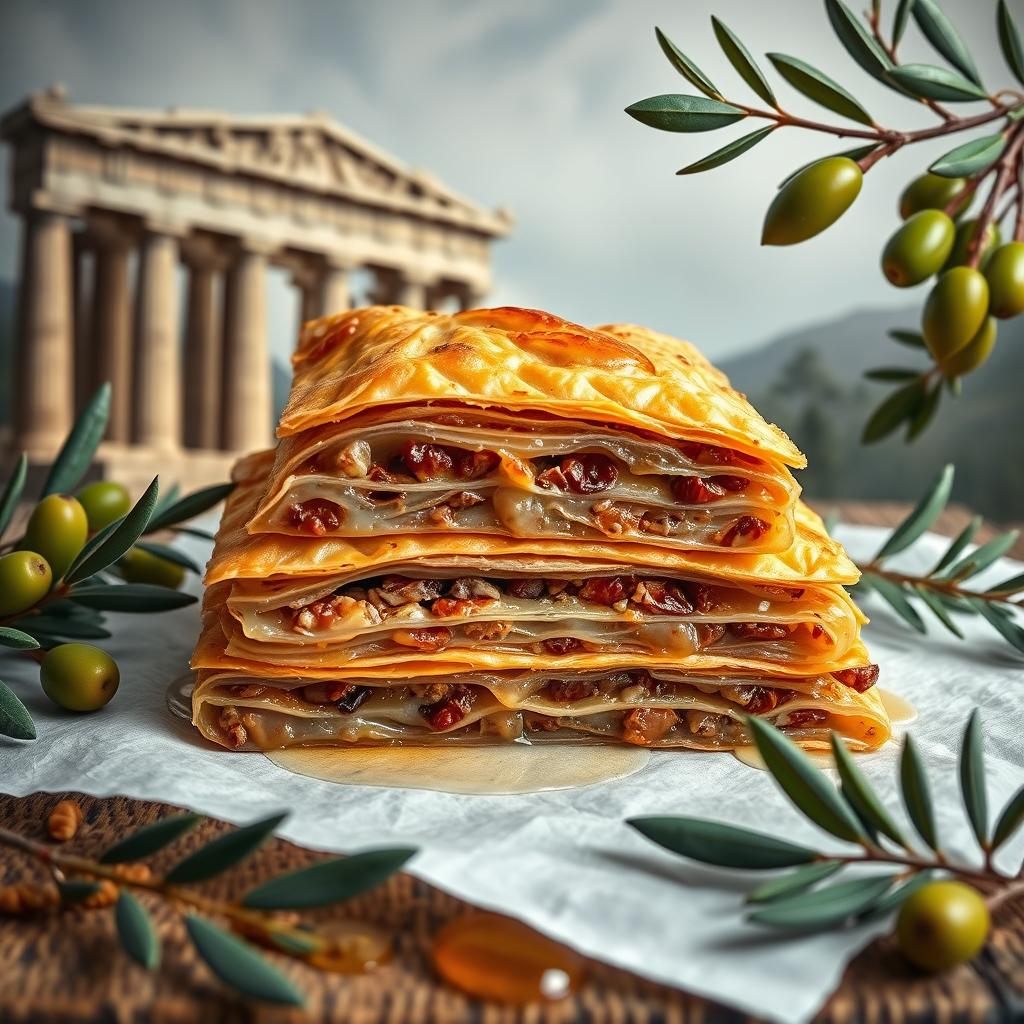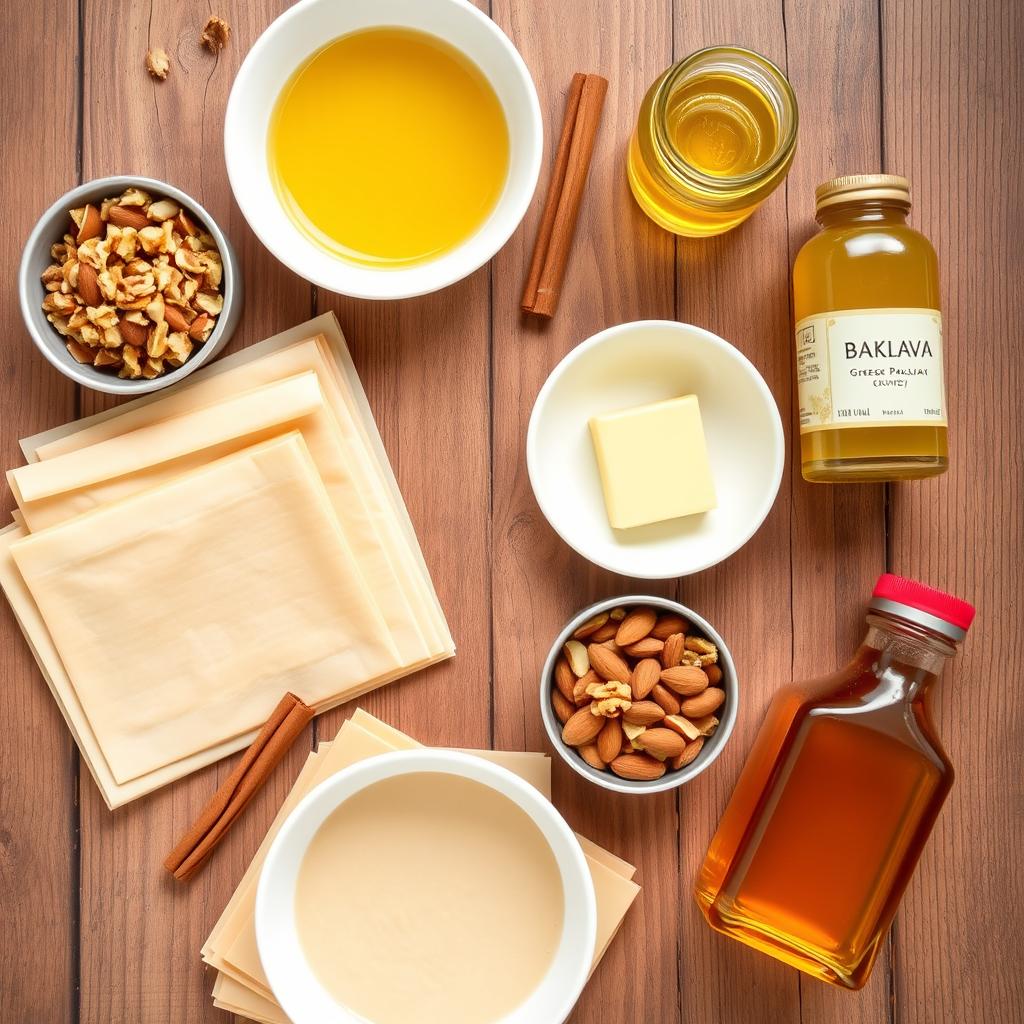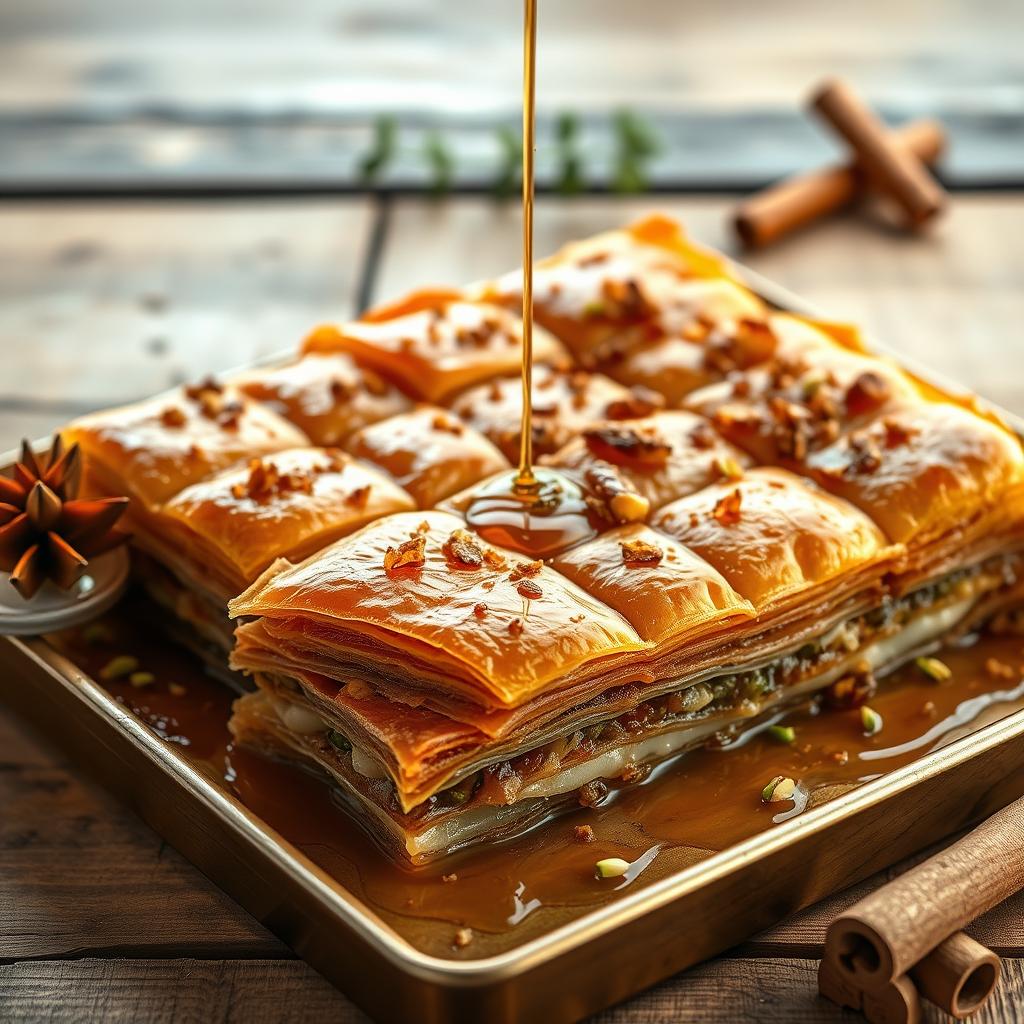Discover the magic of a traditional Greek baklava recipe. It turns simple ingredients into a spectacular dessert. This classic treat combines delicate phyllo dough, rich walnuts, and sweet syrup. It creates a mouthwatering experience that will transport your taste buds straight to the Mediterranean.
Crafting the perfect Greek baklava requires patience and technique. With layers of buttery phyllo dough and a generous nut filling, this dessert represents centuries of culinary tradition. Whether you’re an experienced baker or a curious home cook, this recipe will guide you through creating an authentic sweet delicacy.
Key Takeaways
- Authentic Greek baklava uses thin, delicate phyllo dough
- Walnuts are the traditional nut filling for this dessert
- Homemade syrup is crucial for achieving the perfect sweetness
- Layering technique determines the baklava’s texture
- Butter plays a key role in creating flaky, golden layers
The Rich History of Traditional Greek Baklava
Baklava is a tasty journey through time and cultures. Many argue over its origins, but the Greek version is a standout. It has won the hearts of dessert fans everywhere.

Origins and Cultural Significance
For years, food historians have wondered if baklava is Greek or Arab. It’s made with phyllo dough, nuts, and sweet syrup. Greece made it a national treasure, showing off its rich culture.
“Baklava is more than a dessert; it’s a celebration of culinary tradition and regional pride.” – Greek Culinary Expert
Regional Variations Across Greece
Greece has its own take on baklava. Here are some key differences:
- Aegean Islands: Use local honey and pistachios
- Thessaly: Incorporate walnuts and cinnamon
- Macedonia: Add extra layers of phyllo dough
| Region | Distinctive Ingredient | Flavor Profile |
|---|---|---|
| Crete | Almonds | Subtle and Nutty |
| Athens | Local Thyme Honey | Rich and Sweet |
Why Greek Baklava Stands Out
Greece is known for its amazing baklava. The secret lies in the layering, top-notch ingredients like high-quality nuts, and old recipes. This makes it taste and feel like no other.
Greek bakers are proud of their baklava. They see it as a treasure passed down through generations.
Essential Ingredients for Authentic Greek Baklava Recipe
To make the perfect Greek baklava, you need the right ingredients. These ingredients are what make this dessert so special. Let’s explore what makes baklava authentic.

The base of baklava is phyllo dough. This thin pastry is what makes the dessert flaky. Choose fresh, thin sheets that don’t break easily.
- Nuts are the heart of baklava’s filling. Walnuts and pistachios are traditional choices, each bringing a unique texture and flavor profile.
- Butter is key for that golden, crispy exterior. Use unsalted, high-quality butter for the best results.
Spices make baklava special. A mix of cinnamon and cardamom adds depth and warmth. A little rose water adds elegance and aroma.
| Ingredient | Importance | Recommended Type |
|---|---|---|
| Phyllo Dough | Structural Base | Fresh, thin sheets |
| Walnuts | Primary Filling | Freshly chopped, raw |
| Honey | Sweetening Syrup | Raw, local honey |
“The magic of baklava lies in the perfect balance of its ingredients.”
The final touch is the honey syrup. It turns the pastry into a decadent dessert. Choose high-quality honey that complements the nuts and adds sticky sweetness.
Tools and Equipment You’ll Need
To make a tasty Greek baklava, you need the right baking tools. These tools help you make this traditional dessert easily and precisely. Whether you’re an experienced baker or new to pastry, the right equipment is key.
Before starting your Greek baklava recipe, collect these essential baking tools. They make cooking smooth and fun.
Essential Baking Tools
- 9×13 inch baking pan (preferably glass or ceramic)
- Sharp serrated knife for cutting phyllo layers
- Pastry brush for butter application
- Large mixing bowls
- Measuring cups and spoons
Optional Equipment for Perfect Results
These extra tools can make your Greek baklava even better:
- Kitchen scale for precise ingredient measurements
- Silicone pastry mat for easy dough handling
- Cooling rack for proper syrup absorption
- Offset spatula for smooth syrup distribution
Preparation Setup Guide
Set up your workspace neatly before starting. Keep butter melted, nuts chopped, and phyllo dough covered. This prevents it from drying out.
Pro tip: Always have your tools ready and ingredients measured before beginning your baklava preparation.
| Tool Category | Recommended Options | Price Range |
|---|---|---|
| Baking Pan | Glass or ceramic 9×13 inch | $15-$30 |
| Pastry Brush | Silicone or natural bristle | $5-$15 |
| Knife | Sharp serrated pastry knife | $10-$25 |
With these tools ready, you’re set to make a delicious Greek baklava. It will surely impress your loved ones.
Understanding Phyllo Dough: Tips and Techniques
Phyllo dough is the heart of Greek baklava. It’s delicate and needs patience and skill. To make crispy baklava, you must handle it carefully.
- Thaw frozen phyllo dough completely in the refrigerator
- Keep sheets covered with a damp cloth to prevent drying
- Work quickly and gently to avoid tearing
“Phyllo dough is like silk – handle it with respect, and it will reward you with incredible texture.” – Greek Pastry Chef
To get that crispiness, follow some important steps. Brush each layer with melted butter or olive oil. This makes the baklava irresistibly flaky and crisp.
Temperature is key when working with phyllo dough. Sheets at room temperature are easier to handle. If they dry out, they’ll break, so keep the environment consistent.
Mastering phyllo dough takes practice. Don’t worry if it’s not perfect at first. With time, you’ll make baklava that’s crisp, delicate, and delicious.
Making the Perfect Nut Filling Mixture
Creating the perfect nut filling is key to making authentic Greek baklava. The right mix of nuts and spices can make your dessert go from good to amazing.
Choosing the Right Nuts
Choosing the right nuts is crucial for your baklava’s success. Walnuts and pistachios are top choices, each adding a special flavor. Look for:
- Fresh, high-quality walnuts with a rich, buttery texture
- Vibrant green pistachios that offer a delicate, slightly sweet taste
- Nuts that are finely ground but not powdery
Spice Blend Secrets
The magic of baklava is in its aromatic spice mix. Cinnamon and cardamom are key, making the nut filling special. A professional baker’s secret is to toast the spices lightly before grinding to boost their flavors.
“Spices are the soul of baklava – they transform simple nuts into a culinary masterpiece.” – Greek Baking Tradition
Achieving Ideal Texture
Your nut mixture should be finely ground but not too fine. You want a texture that holds together when layered with phyllo sheets. A food processor can help you get the right consistency.
| Nut Type | Flavor Profile | Texture Recommendation |
|---|---|---|
| Walnuts | Rich, slightly bitter | Coarse grind |
| Pistachios | Subtle, sweet | Fine grind |
Step-by-Step Greek Baklava Assembly Guide
Making traditional Greek baklava needs care and patience. Layering phyllo dough is an art that turns simple parts into a stunning dessert. Knowing why baklava has 33 layers makes baking more meaningful.
Getting your phyllo dough ready is key for the best baklava. Here are the main steps:
- Carefully unroll the phyllo sheets and keep them covered with a damp cloth
- Trim sheets to fit your baking pan exactly
- Brush each layer generously with melted butter
- Distribute nut mixture evenly between layers
“The secret to exceptional baklava lies in the precision of your layers.” – Greek Pastry Chef
The 33 layers symbolize Christ’s life, making baklava more than a dessert. Each layer should be thin and crisp. This creates a delicate texture that’s a joy to eat.
| Layer Type | Purpose | Butter Application |
|---|---|---|
| Bottom Base | Create sturdy foundation | Heavy butter coating |
| Middle Layers | Distribute nut filling | Light butter brushing |
| Top Layers | Achieve golden crispiness | Extra butter for browning |
Pro tip: Work slowly and carefully. Your patience will lead to a perfectly layered Greek baklava recipe that will wow everyone.
Creating the Aromatic Honey Syrup
The soul of any exceptional baklava lies in its syrup. A perfect honey syrup makes the pastry unforgettable. Your syrup will be the secret that makes your Greek dessert a culinary masterpiece.
Syrup Ingredients and Proportions
To make the ideal honey syrup, you need quality ingredients. Gather:
- 1 cup pure honey
- 1 cup water
- 1/2 cup granulated sugar
- 1 cinnamon stick
- 2-3 whole cloves
Timing and Temperature Tips
Preparing the syrup needs careful attention. Start by mixing honey and water in a saucepan over medium heat. Slowly add the sugar, stirring gently to avoid burning. Aim for a syrup that’s light and slightly thick, coating the back of a spoon.
Adding Flavoring Elements
Add a touch of rose water to elevate your syrup. Just a few drops can make it sublime. Rose water gives your honey syrup an aromatic complexity, just like traditional Greek baklava.
“The perfect syrup is the heartbeat of a truly remarkable baklava.” – Greek Pastry Master
Pro tip: Always pour the hot syrup over a completely cooled baklava. This keeps the pastry crisp while it soaks up the sweet, fragrant syrup.
Baking and Cooling Process
Mastering the baking and cooling process is key to perfecting the greek baklava recipe. The secret to crispy baklava is precise temperature control and careful cooling.
To achieve that irresistible crispy texture, follow these essential steps:
- Preheat your oven to 325°F (165°C)
- Place the assembled baklava in the center rack
- Bake for 45-50 minutes until golden brown
- Watch for even coloration across the top
The cooling process is just as important in your greek baklava recipe. Temperature and timing are critical for achieving the perfect crisp.
“Patience is key when cooling baklava – rush this step, and you’ll lose the characteristic crunch.”
What is the secret to crispy baklava? It’s all about the cooling technique. Remove the baklava from the oven and let it rest at room temperature for at least 4 hours before adding the syrup.
| Baking Stage | Temperature | Time | Result |
|---|---|---|---|
| Preheating | 325°F | 10 minutes | Even heat distribution |
| Baking | 325°F | 45-50 minutes | Golden brown layers |
| Cooling | Room temperature | 4-6 hours | Crispy texture |
Pro tip: Use a glass baking dish to help distribute heat evenly and create that signature crispy bottom layer in your greek baklava recipe.
Storage Tips and Shelf Life
Keeping your homemade greek baklava recipe fresh is key. The right storage can keep it crunchy and flavorful for days or weeks.
Storing your greek baklava right is essential. It helps keep the pastry crisp and flavorful.
Best Storage Practices
- Store at room temperature in an airtight container
- Use a container with a tight-fitting lid
- Keep away from direct sunlight and heat sources
- Place parchment paper between layers to prevent sticking
Maintaining Freshness
Your greek baklava can stay fresh for up to a week. The trick is to control moisture and protect the phyllo layers.
| Storage Method | Shelf Life | Quality Preservation |
|---|---|---|
| Room Temperature | 5-7 days | Excellent |
| Refrigerated | 10-14 days | Good |
Freezing and Thawing Guidelines
Freezing is great for long-term storage. Here’s how to keep your greek baklava delicious:
- Wrap individual pieces in plastic wrap
- Place in a freezer-safe container
- Freeze for up to 3 months
- Thaw at room temperature for 2-3 hours before serving
“The secret to perfect baklava is not just in the making, but in the careful preservation of its delicate layers.” – Greek Culinary Tradition
By storing your greek baklava correctly, it will stay delicious. Enjoy the fruits of your labor!
Conclusion
Making an authentic Greek baklava recipe is more than just following steps. It’s about connecting with a rich culinary tradition. The journey through layers of crisp phyllo, sweet honey syrup, and perfectly crushed nuts turns an ordinary dessert into an extraordinary experience.
What makes Greek baklava different is its commitment to precision and cultural heritage. Each delicate layer represents generations of baking wisdom passed down through family kitchens across Greece. By understanding the techniques and respecting the ingredients, you can recreate this classic dessert with confidence and authenticity.
Your homemade Greek baklava will not just be a sweet treat but a testament to your culinary skills. The intricate process of layering, filling, and soaking ensures a dessert that is simultaneously crisp, tender, and richly flavored. Whether you’re preparing it for a special occasion or simply indulging in a delightful afternoon snack, your baklava will surely impress.
Remember that practice makes perfect. Each time you prepare this classic Greek dessert, you’ll refine your technique and develop a deeper appreciation for this timeless culinary art. Embrace the process, enjoy the aromas, and savor every delectable bite of your homemade baklava.
FAQ
What makes Greek baklava different from other versions?
Greek baklava stands out for its honey syrup and layers of phyllo dough. It also uses a mix of nuts like walnuts. This version is lighter and sweeter, thanks to the honey syrup and spices like cinnamon.
Is baklava originally Greek or Arab?
Baklava’s origins are unclear. Greeks have made it famous, but it likely started in the Ottoman Empire. It has roots in ancient Assyrian and Persian cooking. Each culture has put its own twist on the recipe.
What is the secret to making crispy baklava?
Crispy baklava comes from three things: handling phyllo right, buttering each layer, and baking at the right temperature. Work fast with the phyllo, butter it well, and bake at 350°F until it’s golden and crispy.
Why do traditional baklava recipes use 33 layers?
The 33 layers symbolize Jesus Christ’s 33 years in Christian tradition. This is common in Greek and Middle Eastern baking. It adds a layer of meaning to the dessert.
What are the best nuts to use in Greek baklava?
Walnuts are the top choice for Greek baklava, adding a rich flavor. Some recipes also use pistachios for extra taste and looks. The nuts are ground or chopped finely for a smooth filling.
How long does homemade baklava last?
Homemade baklava stays fresh for up to two weeks in an airtight container. Refrigeration can extend this to a month. Freezing it for up to three months keeps it fresh, as long as it’s wrapped well.
Can I make baklava without rose water?
Yes, you can! Rose water is optional. You can use orange blossom water, vanilla, or skip it. The honey syrup will still make the baklava flavorful.

